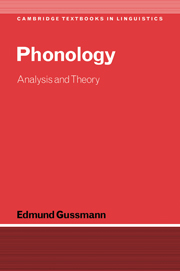Book contents
- Frontmatter
- Contents
- Preface
- List of abbreviations
- 1 Sounds and segments
- 2 The melody and the skeleton
- 3 Domains and phonological regularities
- 4 The syllable
- 5 More on codas
- 6 Some segmental regularities
- 7 Syllable structure and phonological effects: quantity in Icelandic
- 8 Segmental double agents
- 9 Words and feet: stress in Munster Irish
- Conclusion
- Appendix The phonetic alphabet of the International Phonetic Association
- References
- Index
6 - Some segmental regularities
Published online by Cambridge University Press: 05 June 2012
- Frontmatter
- Contents
- Preface
- List of abbreviations
- 1 Sounds and segments
- 2 The melody and the skeleton
- 3 Domains and phonological regularities
- 4 The syllable
- 5 More on codas
- 6 Some segmental regularities
- 7 Syllable structure and phonological effects: quantity in Icelandic
- 8 Segmental double agents
- 9 Words and feet: stress in Munster Irish
- Conclusion
- Appendix The phonetic alphabet of the International Phonetic Association
- References
- Index
Summary
Introduction
In the previous chapters we considered some of the basic notions relating to phonological representations and phonological generalisations. Crucial to them was the structuring of representations and the need to identify separate tiers within them. Each tier operates with units of its own (skeletal positions, melodies, syllabic constituents) which are connected with units of the other levels. An important concern in the theory of tiers is the presence of a unit at one level without any associated unit at a directly adjacent level, i.e. skeletal positions without attached melodies (empty positions), melodies unattached to positions (floating melodies) and syllabic constituents with no skeletal positions (empty onsets).
Phonological generalisations may hold for units at one level only. Often, however, what directly concerns one level will have consequences for units at other levels. Identifying and formulating generalisations involves making hypotheses about levels, units and interactions both between levels and between consecutive units at a given level. So far we have seen that phonological regularities embrace associations between levels, severed associations and conditions on adjacency including sharing relations.
In this chapter we will take a closer look at a few phonological phenomena in some detail. We will want to identify and capture the regularities which the data contain. When formulating the regularities we have to make assumptions that allow us to come up with reasonably satisfactory solutions. These assumptions should be held up for constant scrutiny – no description is possible without theoretical assumptions.
Information
- Type
- Chapter
- Information
- PhonologyAnalysis and Theory, pp. 118 - 156Publisher: Cambridge University PressPrint publication year: 2002
